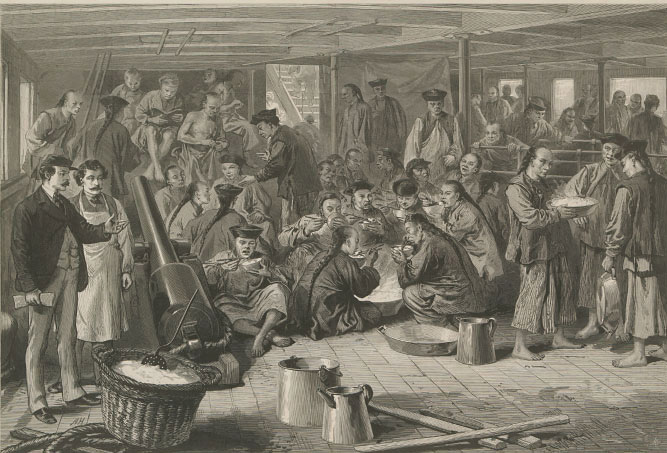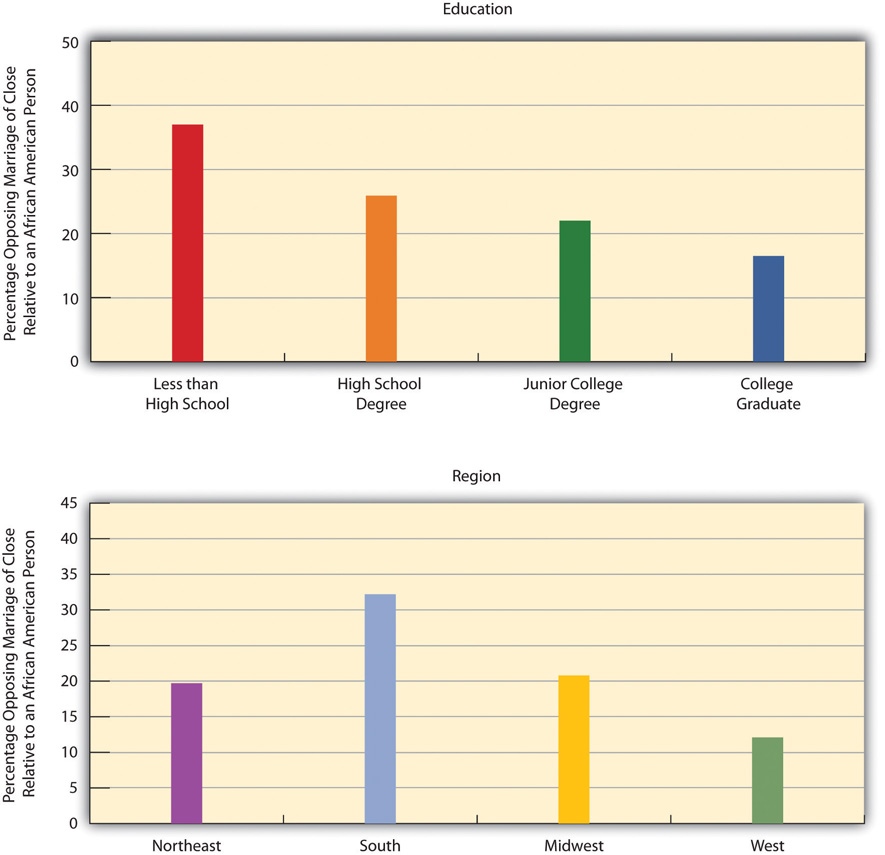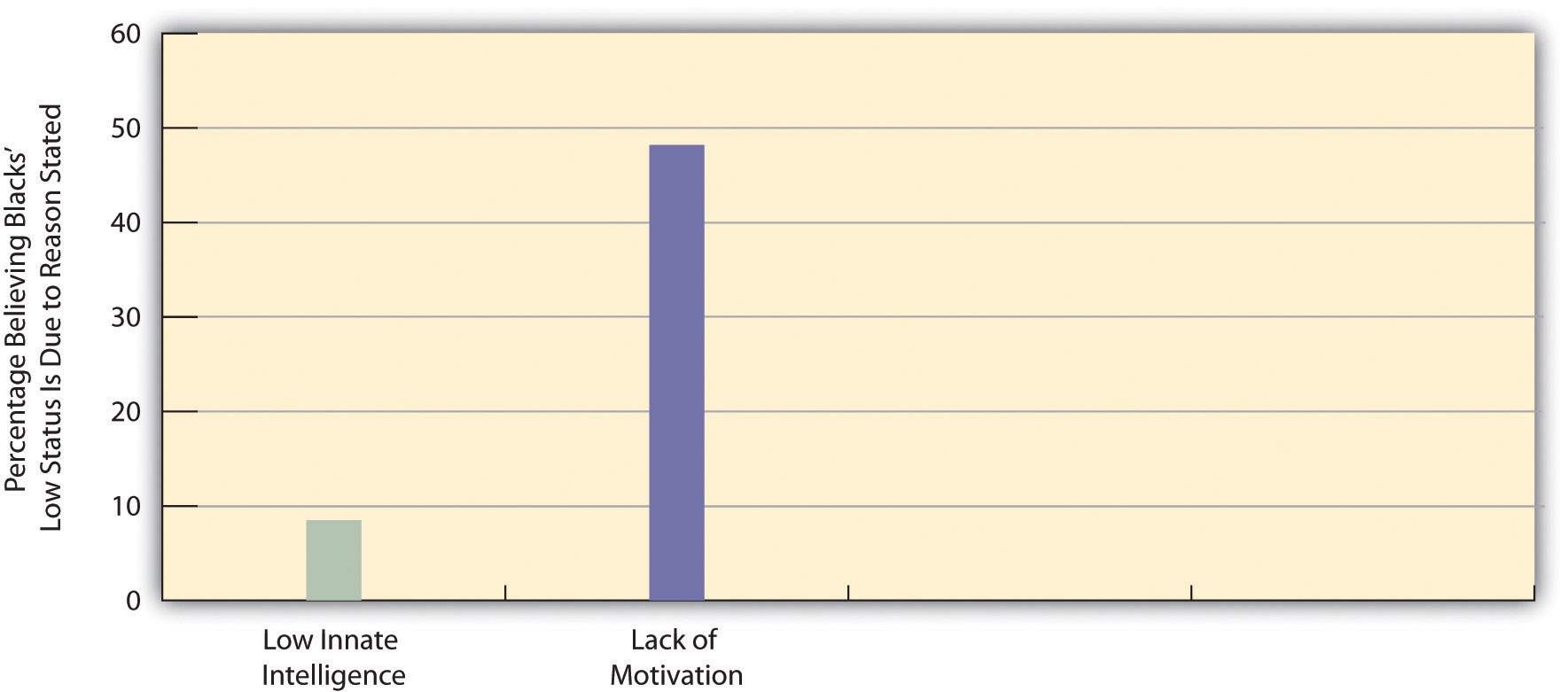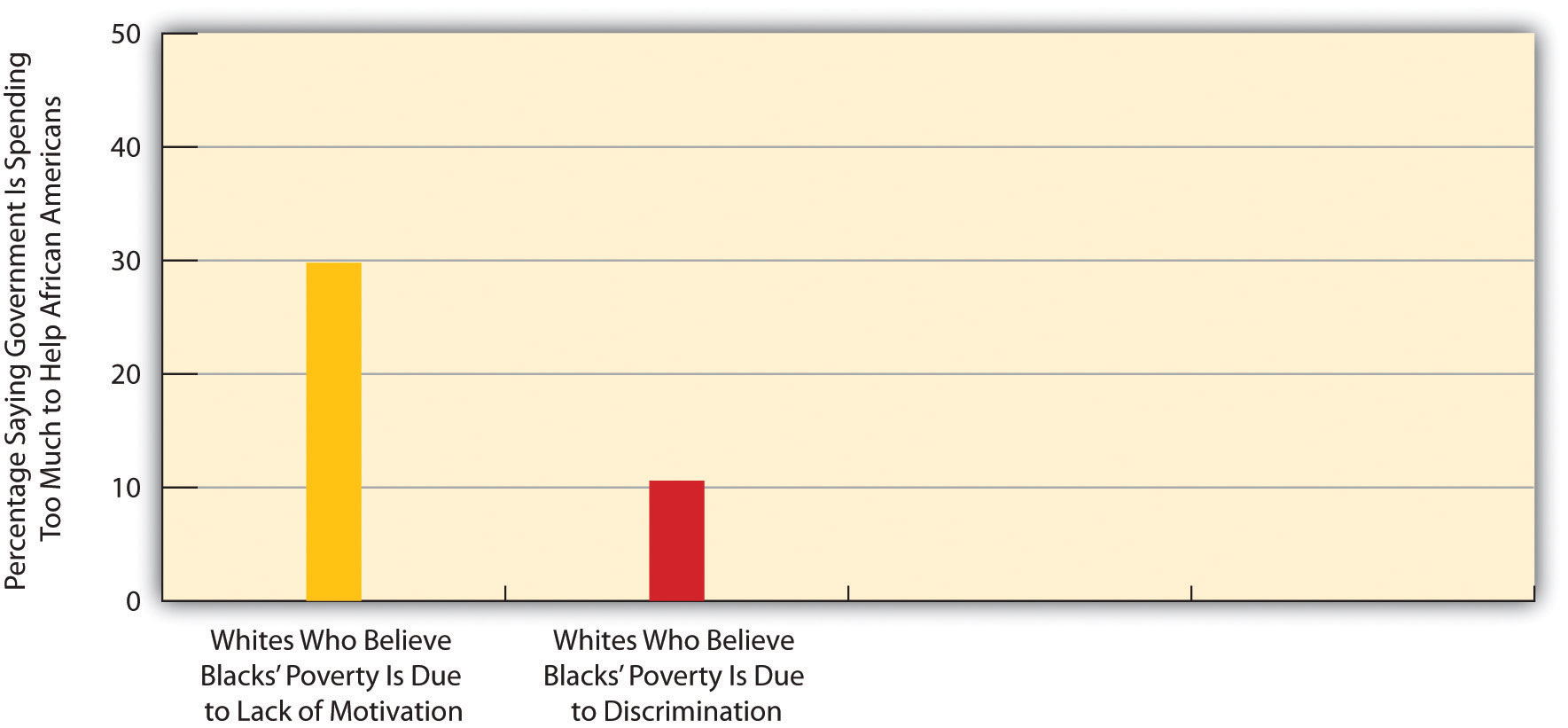3.3: Prejudice
- Last updated
- Save as PDF
- Page ID
- 154516

- Anonymous
- LibreTexts
Learning Objectives
- Define prejudice, racism, and stereotypes.
- Discuss the major social-psychological and sociological theories of prejudice.
- Describe how the nature of prejudice has changed.
Prejudice and discrimination (discussed in the next section) are often confused, but the basic difference between them is this: Prejudice is the attitude, while discrimination is the behavior. More specifically, racial and ethnic prejudice refers to a set of negative attitudes, beliefs, and judgments about whole categories of people, and about individual members of those categories, because of their perceived race and/or ethnicity. A closely related concept is racism, or the belief that certain racial or ethnic groups are inferior to one’s own. Prejudice and racism are often based on racial and ethnic stereotypes, or simplified, mistaken generalizations about people because of their race and/or ethnicity. While cultural and other differences do exist among the various American racial and ethnic groups, many of the views we have of such groups are unfounded and hence are stereotypes. An example of the stereotypes that white people have of other groups appears in Figure 3.1 “Perceptions by Non-Latino White Respondents of the Intelligence of White and Black Americans”, in which white respondents in the General Social Survey (GSS), a recurring survey of a random sample of the US population, are less likely to think blacks are intelligent than they are to think whites are intelligent.
Figure 3.1 Perceptions by Non-Latino White Respondents of the Intelligence of White and Black Americans

Source: Data from General Social Survey. (2010). Retrieved from http://sda.berkeley.edu/cgi-bin/hsda?harcsda+gss10.
Explaining Prejudice
Where does racial and ethnic prejudice come from? Why are some people more prejudiced than others? Scholars have tried to answer these questions at least since the 1940s, when the horrors of Nazism were still fresh in people’s minds. Theories of prejudice fall into two camps, social-psychological and sociological. We will look at social-psychological explanations first and then turn to sociological explanations. We will also discuss distorted mass media treatment of various racial and ethnic groups.
Social-Psychological Explanations
One of the first social-psychological explanations of prejudice centered on the authoritarian personality (Adorno, Frenkel-Brunswick, Levinson, & Sanford, 1950).Adorno, T. W., Frenkel-Brunswick, E., Levinson, D. J., & Sanford, R. N. (1950). The authoritarian personality. New York, NY: Harper. According to this view, authoritarian personalities develop in childhood in response to parents who practice harsh discipline. Individuals with authoritarian personalities emphasize such things as obedience to authority, a rigid adherence to rules, and low acceptance of people (out-groups) not like oneself. Many studies find strong racial and ethnic prejudice among such individuals (Sibley & Duckitt, 2008).Sibley, C. G., & Duckitt, J. (2008). Personality and prejudice: A meta-analysis and theoretical review. Personality and Social Psychology Review, 12, 248–279. But whether their prejudice stems from their authoritarian personalities or instead from the fact that their parents were probably prejudiced themselves remains an important question.

Authoritarian personalities are said to develop in childhood from harsh parental discipline and to be linked to racial and ethnic prejudice. Although many people with authoritarian personalities are prejudiced, it remains unclear whether their prejudice stems from their personalities or from their parents’ own prejudice. © Thinkstock
Another early and still popular social-psychological explanation is called frustration theory (or scapegoat theory) (Dollard, Doob, Miller, Mowrer, & Sears, 1939).Dollard, J., Doob, L. W., Miller, N. E., Mowrer, O. H., & Sears, R. R. (1939). Frustration and Aggression. New Haven, CT: Yale University Press. In this view individuals with various problems become frustrated and tend to blame their troubles on groups that are often disliked in the real world (e.g., racial, ethnic, and religious minorities). These minorities are thus scapegoats for the real sources of people’s misfortunes. Several psychology experiments find that when people are frustrated, they indeed become more prejudiced. In one early experiment, college students who were purposely not given enough time to solve a puzzle were more prejudiced after the experiment than before it (Cowen, Landes, & Schaet, 1959).Cowen, E. L., Landes, J., & Schaet, D. E. (1959). The effects of mild frustration on the expression of prejudiced attitudes. Journal of Abnormal and Social Psychology, 64, 33–38.
Sociological Explanations
One popular sociological explanation emphasizes conformity and socialization and is called social learning theory. In this view, people who are prejudiced are merely conforming to the culture in which they grow up, and prejudice is the result of socialization from parents, peers, the news media, and other various aspects of their culture. Supporting this view, studies have found that people tend to become more prejudiced when they move to areas where people are very prejudiced and less prejudiced when they move to locations where people are less prejudiced (Aronson, 2008).Aronson, E. (2008). The social animal (10th ed.). New York, NY: Worth. If people in the South today continue to be more prejudiced than those outside the South, as we discuss later, even though legal segregation ended more than four decades ago, the influence of their culture on their socialization may help explain these beliefs.
Children and Our Future - Growing Up as Farmworkers’ Kids
In the large agricultural fields of California work thousands of farmworkers and their families. Adults and children alike live in poor, crowded conditions and do backbreaking work in the hot sun, day after day after day.
Because their parents are migrant workers, many children attend a specific school for only a few weeks or months at most before their parents move to another field in another town or even another state. At Sherwood Elementary School in Salinas, California, in the heart of the state’s agricultural sector, 97 percent of students live in or near poverty. With their Latino backgrounds, more than three-fourths do not speak English well or at all, and many of their parents cannot read or write their own language, Spanish.
At the Sherwood school, according to a news report, many students “sleep beneath carports and live in such cramped quarters that their parents take them to the local truck stop to wash up before school.” A local high school teacher said many of his students see little of their parents, who spend most of their waking hours working in the fields. “They have little brothers and sisters to take care of, maybe cook for. Yet they’re supposed to turn in a 10-page paper by tomorrow? I mean, it’s unreal.”
These conditions have grievous consequences for California’s migrant farmworker children, almost half of whom fail to complete high school. The principal of the Sherwood Elementary School said the key strategy for her faculty and school was “understanding where the students come from but also having high expectations.”
The plight of farmworkers’ children is just one aspect of the difficulties facing Latino children around the country. Thanks to reproduction and immigration, the number of Latino children nationwide has grown significantly during the past few decades: in 2009, 23 percent of US kindergarten children were Latino, compared to only 10 percent in 1989. These growing numbers underscore the need to pay attention to the health and welfare of Latino children.
Against this backdrop, it is distressing to note that their health and welfare is not very good at all. About one-third of Latino children live in poverty. The average Latino child grows up in a poor neighborhood where almost half of the residents do not speak English fluently, where the schools are substandard, and where the high school dropout and teen unemployment rates are high. A number of factors, including their ethnicity, poverty, language barriers, and the immigrant status of many of their parents, limit Latino children’s access to adequate health care and various kinds of social services.
Amid all these problems, however, the situation of California’s farmworker children stands out as a national embarrassment for a prosperous country like the United States. As the country struggles to end racial and ethnic inequality, it must not forget the children of Salinas who have to use a truck stop to wash up before school.
Sources: P. L. Brown, 2011; Landale, McHale, & Booth, 2011; Tavernise, 2011Brown, P. L. (2011, March 13). Itinerant life weighs on farmworkers’ children. New York Times, p. A18; Landale, N. S., McHale, S., & Booth, A. (Eds.). (2011). Growing up Hispanic: Health and development of children of immigrants. Washington, DC: Urban Institute Press; Tavernise, S. (2011, February 8). Among nation’s youngest, analysis finds fewer whites. New York Times, p. A14.
The mass media play a key role in how many people learn to be prejudiced. This type of learning happens because the media often present people of color in a negative light. By doing so, the media unwittingly reinforce the prejudice that individuals already have or even increase their prejudice (Larson, 2005).Larson, S. G. (2005). Media & minorities: The politics of race in news and entertainment. Lanham, MD: Rowman & Littlefield. Examples of distorted media coverage abound. Even though poor people are more likely to be white than any other race or ethnicity (see Chapter 2), the news media use pictures of African Americans far more often than those of whites in stories about poverty. In one study, national news magazines, such as Time and Newsweek, and television news shows portrayed African Americans in almost two-thirds of their stories on poverty, even though only about one-fourth of poor people are African Americans. In the magazine stories, only 12 percent of the African Americans had a job, even though in the real world more than 40 percent of poor African Americans were working at the time the stories were written (Gilens, 1996).Gilens, M. (1996). Race and poverty in America: Public misperceptions and the American news media. Public Opinion Quarterly, 60, 515–541. In a Chicago study, television news shows there depicted whites fourteen times more often in stories of good Samaritans, even though whites and African Americans live in Chicago in roughly equal numbers (Entman & Rojecki, 2001).Entman, R. M., & Rojecki, A. (2001). The black image in the white mind. Chicago, IL: University of Chicago Press. Many other studies find that newspaper and television stories about crime and drugs feature higher proportions of African Americans as offenders than is true in arrest statistics (Surette, 2011).Surette, R. (2011). Media, crime, and criminal justice: Images, realities, and policies (4th ed.). Belmont, CA: Wadsworth. Studies like these show that the news media “convey the message that black people are violent, lazy, and less civic minded” (Jackson, 1997, p. A27).Jackson, D. Z. (1997, December 5). Unspoken during race talk. The Boston Globe, p. A27.
A second sociological explanation emphasizes economic and political competition and is commonly called group threat theory (Quillian, 2006).Quillian, L. (2006). New approaches to understanding racial prejudice and discrimination. Annual Review of Sociology, 32, 299–328. In this view, prejudice arises from competition over jobs and other resources and from disagreement over various political issues. When groups vie with each other over these matters, they often become hostile toward each other. Amid such hostility, it is easy to become prejudiced toward the group that threatens your economic or political standing. A popular version of this basic explanation is Susan Olzak’s (1992)Olzak, S. (1992). The dynamics of ethnic competition and conflict. Stanford, CA: Stanford University Press. ethnic competition theory, which holds that ethnic prejudice and conflict increase when two or more ethnic groups find themselves competing for jobs, housing, and other goals.
The competition explanation is the macro equivalent of the frustration/scapegoat theory already discussed. Much of the white mob violence discussed earlier stemmed from whites’ concern that the groups they attacked threatened their jobs and other aspects of their lives. Thus lynchings of African Americans in the South increased when the Southern economy worsened and decreased when the economy improved (Tolnay & Beck, 1995).Tolnay, S. E., & Beck, E. M. (1995). A festival of violence: An analysis of southern lynchings, 1882–1930. Urbana, IL: University of Illinois Press. Similarly, white mob violence against Chinese immigrants in the 1870s began after the railroad construction that employed so many Chinese immigrants slowed and the Chinese began looking for work in other industries. Whites feared that the Chinese would take jobs away from white workers and that their large supply of labor would drive down wages. Their assaults on the Chinese killed several people and prompted the passage by Congress of the Chinese Exclusion Act in 1882 that prohibited Chinese immigration (Dinnerstein & Reimers, 2009).Dinnerstein, L., & Reimers, D. M. (2009). Ethnic Americans: A history of immigration. New York, NY: Columbia University Press.

During the 1870s, whites feared that Chinese immigrants would take away their jobs. This fear led to white mob violence against the Chinese and to an act of Congress that prohibited Chinese immigration. Image courtesy of Marku1988, http://commons.wikimedia.org/wiki/File:Chinese_Emigration_to_America.jpg.
Correlates of Prejudice
Since the 1940s, social scientists have investigated the individual correlates of racial and ethnic prejudice (Stangor, 2009).Stangor, C. (2009). The study of stereotyping, prejudice, and discrimination within social psychology: A quick history of theory and research. In T. D. Nelson (Ed.), Handbook of prejudice, stereotyping, and discrimination (pp. 1–22). New York, NY: Psychology Press. These correlates help test the theories of prejudice just presented. For example, if authoritarian personalities do produce prejudice, then people with these personalities should be more prejudiced. If frustration also produces prejudice, then people who are frustrated with aspects of their lives should also be more prejudiced. Other correlates that have been studied include age, education, gender, region of country, race, residence in integrated neighborhoods, and religiosity. We can take time here to focus on gender, education, and region of country and discuss the evidence for the racial attitudes of whites, as most studies do in view of the historic dominance of whites in the United States.
The findings on gender are rather surprising. Although women are usually thought to be more empathetic than men and thus to be less likely to be racially prejudiced, recent research indicates that the racial views of (white) women and men are in fact very similar and that the two genders are about equally prejudiced (Hughes & Tuch, 2003).Hughes, M., & Tuch, S. A. (2003). Gender differences in whites’ racial attitudes: Are women’s attitudes really more favorable? Social Psychology Quarterly, 66, 384–401. This similarity supports group threat theory, outlined earlier, in that it indicates that white women and men are responding more as whites than as women or men, respectively, in formulating their racial views.
Findings on education and region of country are not surprising. Focusing again just on whites, less educated people are usually more racially prejudiced than better-educated people, and Southerners are usually more prejudiced than non-Southerners (Krysan, 2000).Krysan, M. (2000). Prejudice, politics, and public opinion: Understanding the sources of racial policy attitudes. Annual Review of Sociology, 26, 135–168. Evidence of these differences appears in Figure 3.2, which depicts educational and regional differences in a type of racial prejudice that social scientists call social distance, or feelings about interacting with members of other races and ethnicities. The General Social Survey asks respondents how they feel about a “close relative” marrying an African American. Figure 3.2 shows how responses by white (non-Latino) respondents to this question vary by education and by Southern residence. Whites without a high school degree are much more likely than those with more education to oppose these marriages, and whites in the South are also much more likely than their non-Southern counterparts to oppose them. To recall the sociological perspective (see Chapter 1), our social backgrounds certainly do seem to affect our attitudes.
Figure 3.2 Education, Region, and Opposition by Non-Latino Whites to a Close Relative Marrying an African American

Source: Data from General Social Survey. (2010). Retrieved from http://sda.berkeley.edu/cgi-bin/hsda?harcsda+gss10.
The Changing Nature of Prejudice
Although racial and ethnic prejudice still exists in the United States, its nature has changed during the past half-century. Studies of these changes focus on whites’ perceptions of African Americans. Back in the 1940s and before, an era of overt Jim Crow racism (also called traditional or old-fashioned racism) prevailed, not just in the South but in the entire nation. This racism involved blatant bigotry, firm beliefs in the need for segregation, and the view that blacks were biologically inferior to whites. In the early 1940s, for example, more than half of all whites thought that blacks were less intelligent than whites, more than half favored segregation in public transportation, more than two-thirds favored segregated schools, and more than half thought whites should receive preference over blacks in employment hiring (Schuman, Steeh, Bobo, & Krysan, 1997).Schuman, H., Steeh, C., Bobo, L., & Krysan, M. (1997). Racial attitudes in America: Trends and interpretations (Rev. ed.). Cambridge, MA: Harvard University Press.
The Nazi experience and then the civil rights movement led whites to reassess their views, and Jim Crow racism gradually waned. Few whites believe today that African Americans are biologically inferior, and few favor segregation. So few whites now support segregation and other Jim Crow views that national surveys no longer include many of the questions that were asked a half-century ago.
But that does not mean that prejudice has disappeared. Many scholars say that Jim Crow racism has been replaced by a more subtle form of racial prejudice, termed laissez-faire, symbolic, or modern racism, that amounts to a “kinder, gentler, antiblack ideology” that avoids notions of biological inferiority (Bobo, Kluegel, & Smith, 1997, p. 15; Quillian, 2006; Sears, 1988).Bobo, L., Kluegel, J. R., & Smith, R. A. (1997). Laissez-faire racism: The crystallization of a kinder, gentler, antiblack ideology. In S. A. Tuch & J. K. Martin (Eds.), Racial attitudes in the 1990s: Continuity and change (pp. 15–44). Westport, CT: Praeger; Quillian, L. (2006). New approaches to understanding racial prejudice and discrimination. Annual Review of Sociology, 32, 299–328; Sears, D. O. (1988). Symbolic racism. In P. A. Katz & D. A. Taylor (Eds.), Eliminating racism: Profiles in controversy (pp. 53–84). New York, NY: Plenum. Instead, it involves stereotypes about African Americans, a belief that their poverty is due to their cultural inferiority, and opposition to government policies to help them. Similar views exist about Latinos. In effect, this new form of prejudice blames African Americans and Latinos themselves for their low socioeconomic standing and involves such beliefs that they simply do not want to work hard.
Evidence for this modern form of prejudice is seen in Figure 3.3, which presents whites’ responses to two General Social Survey (GSS) questions that asked, respectively, whether African Americans’ low socioeconomic status is due to their lower “in-born ability to learn” or to their lack of “motivation and will power to pull themselves up out of poverty.” While only 8.5 percent of whites attributed blacks’ status to lower innate intelligence (reflecting the decline of Jim Crow racism), about 48 percent attributed it to their lack of motivation and willpower. Although this reason sounds “kinder” and “gentler” than a belief in blacks’ biological inferiority, it is still one that blames African Americans for their low socioeconomic status.
Figure 3.3 Attribution by Non-Latino Whites of Blacks’ Low Socioeconomic Status to Blacks’ Low Innate Intelligence and to Their Lack of Motivation to Improve

Source: Data from General Social Survey. (2010). Retrieved from http://sda.berkeley.edu/cgi-bin/hsda?harcsda+gss10.
Prejudice and Public Policy Preferences
If whites do continue to believe in racial stereotypes, say the scholars who study modern prejudice, they are that much more likely to oppose government efforts to help people of color. For example, whites who hold racial stereotypes are more likely to oppose government programs for African Americans (Quillian, 2006).Quillian, L. (2006). New approaches to understanding racial prejudice and discrimination. Annual Review of Sociology, 32, 299–328. We can see an example of this type of effect in Figure 3.4, which compares two groups: whites who attribute blacks’ poverty to lack of motivation, and whites who attribute blacks’ poverty to discrimination. Those who cite lack of motivation are more likely than those who cite discrimination to believe the government is spending too much to help blacks.
Figure 3.4 Racial Stereotyping by Non-Latino Whites and Their Opposition to Government Spending to Help African Americans

Source: Data from General Social Survey. (2010). Retrieved from http://sda.berkeley.edu/cgi-bin/hsda?harcsda+gss10.

Whites who are racially prejudiced are more likely to favor harsher treatment of criminals and in particular are more likely to support the death penalty.
© Thinkstock
Racial prejudice influences other public policy preferences as well. In the area of criminal justice, whites who hold racial stereotypes or hostile feelings toward African Americans are more likely to be afraid of crime, to think that the courts are not harsh enough, to support the death penalty, to want more money spent to fight crime, and to favor excessive use of force by police (Barkan & Cohn, 2005; Unnever & Cullen, 2010).Barkan, S. E., & Cohn, S. F. (2005). Why whites favor spending more money to fight crime: The role of racial prejudice. Social Problems, 52, 300–314; Unnever, J. D., & Cullen, F. T. (2010). The social sources of Americans’ punitiveness: A test of three competing models. Criminology, 48, 99–129.
If racial prejudice influences views on all these issues, then these results are troubling for a democratic society like the United States. In a democracy, it is appropriate for the public to disagree on all sorts of issues, including criminal justice. For example, citizens hold many reasons for either favoring or opposing the death penalty. But is it appropriate for racial prejudice to be one of these reasons? To the extent that elected officials respond to public opinion, as they should in a democracy, and to the extent that racial prejudice affects public opinion, then racial prejudice may be influencing government policy on criminal justice and on other issues. In a democratic society, it is unacceptable for racial prejudice to have this effect.
KEY TAKEAWAYS
- Social-psychological explanations of prejudice emphasize authoritarian personalities and frustration, while sociological explanations emphasize social learning and group threat.
- Education and region of residence are related to racial prejudice among whites; prejudice is higher among whites with lower levels of formal education and among whites living in the South.
- Jim Crow racism has been replaced by symbolic or modern racism that emphasizes the cultural inferiority of people of color.
- Racial prejudice among whites is linked to certain views they hold about public policy. Prejudice is associated with lower support among whites for governmental efforts to help people of color and with greater support for a more punitive criminal justice system.
FOR YOUR REVIEW
- Think about the last time you heard someone say a remark that was racially prejudiced. What was said? What was your reaction?
- The text argues that it is inappropriate in a democratic society for racial prejudice to influence public policy. Do you agree with this argument? Why or why not?

